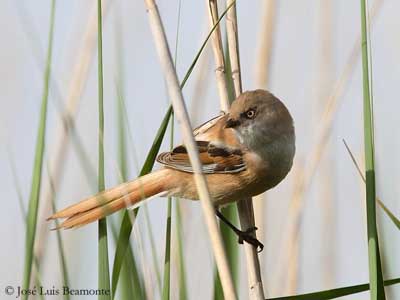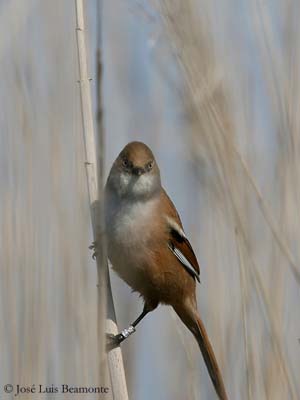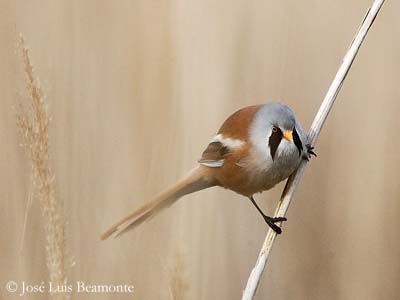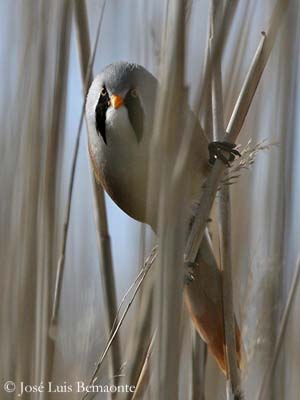Fr: Panure à moustaches
All : Bartmeise
Esp : Bigotudo
Ital: Basettino
Nd: Baardmannetje
Sd: Skäggmes
Photographs by José Luis Beamonte
Pájaros de España
Text by Nicole Bouglouan
Sources:
HANDBOOK OF THE BIRDS OF THE WORLD Vol 12 by Josep del Hoyo-Andrew Elliott-David Christie - Lynx Edicions - ISBN: 8496553423
THE HANDBOOK OF BIRD IDENTIFICATION FOR EUROPE AND THE WESTERN PALEARCTIC by Mark Beaman, Steve Madge - C.Helm - ISBN: 0713639601
THE COMPLETE BOOK OF BRITISH BIRDS – Written by “Royal Society for the Protection of Birds” experts - Préface de Magnus Magnusson - Michael Cady- Rob Hume Editors - ISBN: 0749509112
L’ENCYCLOPEDIE MONDIALE DES OISEAUX - Dr Christopher M. Perrins - BORDAS - ISBN: 2040185607
ENCYCLOPEDIE DES OISEAUX DE FRANCE ET D’EUROPE – de Peter Hayman et Rob Hume - Flammarion – ISBN : 2082009920
Pájaros de España (JL Beamonte)
Bearded Tit or Bearded Reedling
Panurus biarmicus
Passeriforme Order – Timaliidae Family
BIOMETRICS:
Length: 15-17 cm
Weight: 11-20 g
DESCRIPTION:
The Bearded Tit, in spite of its name, is not a tit. With behaviour very similar to that of Sedge Warbler or other inhabitant of the reedbeds, this bird is really striking with the conspicuous black moustache of the male.
Adult male has pale rufous-chestnut upperparts, body sides, flanks and uppertail feathers.
The upperwing shows white, rufous and black flight feathers. Scapulars are buffy-white, extending to the back and forming a V or a U. The primary coverts are dark greyish-black. The flight feathers have white edges. The long, graduated tail is rufous-chestnut above.
On the underparts, chin, throat, breast and belly are white. Vent and undertail-coverts are black. Undertail rectrices are graduated and white.
On the head, forehead, crown, ear-coverts and nape are pale blue-grey. A conspicuous black “moustache” extends from the black lores and cheeks, down to the sides of the bill, along the malar area to the throat sides.
The pointed, thin bill and the eyes are yellow. Legs and feet are black.
The female differs by the head pattern. She has drab brown face and crown, with often some dark brown mottling on centre. Lores, chin, throat and neck sides are pale grey.
Her body is slightly paler than in male, and she has warm buff (not black) undertail-coverts.

The juvenile resembles female but it is less chestnut above, on flanks and central uppertail feathers. The lower mantle is black. The wings are black with pale fringes.
The underparts are duller.
The young male has blackish lores, yellow-green eyes and yellow to orange bill.
The young female has dull grey lores, slightly mottled buff. The bill is darker, horn-brown, grey-brown or blackish.
We can find three subspecies which differ in amount of black on the male’s head and depth of body colours in female.
The race “russicus” is paler overall than nominate.
The race “kosswigi” is darker above.

VOICE:
The Bearded Tit’s typical call is a nasal, far-carrying “ping-ping” or “tying-tying”. This bird also gives harsh, buzzing “tjick” when excited and a soft “pitt” near the nest.
The alarm call is a scolding “schra”, or “t-tzaaaah” or “djschur”. The contact call is a very soft “djipp” or “djupp”.
The trisyllabic song is a soft “tchin-tchick-tchraay”.
HABITAT:
The Bearded Tit frequents the reedbeds and the associated vegetation, in or beside fresh and brackish water, marshes and swamps.
Along the shores of lakes and rivers, it can be found in reedbeds and stands of reeds and bulrushes of genus Typha.
This species occurs from sea-level to medium elevation, but higher according to the range (up to 3000 metres in China).
RANGE:
The Bearded Tit occurs in temperate Europe and Asia, from Western Europe, Turkey, Iran to Manchuria.
BEHAVIOUR:
The Bearded Tit feeds mainly on insects such as mayflies during summer, but in winter, it consumes more seeds, and particularly those of reeds.
It tends to catch mainly slow-moving insects, and during the breeding season, it consumes large numbers of larvae and pupae of various moths’ species. These caterpillars are the typical food brought to the nest.
They forage in pairs and family groups. After the breeding season, flocks of up to 40-50 birds or more can feed together.
They feed near water, often at the base of the reeds, and they forage in muddy areas. They climb to the top of the reeds and fly above the reedbed over short distances.
They catch flying insects and can feed upside-down. They are able to extract the seeds with the bill or the foot.
The Bearded Tit hops and runs quickly on the ground. It scratches the soil and turns over the leaves when searching for preys.
During winter, it takes the fallen seeds and can probe the snow for food if necessary.

This bird is able to perch between two reeds, grasping each stem with one foot. The pairs often sleep together perched on a reed stem.
The Bearded Tits roost in row, close to each other in physical contact, on reed stems.
The courtship displays seem to be simple, with the male hopping towards the female with raised wings and uttering nasal and ringing “ping” notes. There also are some chases between them, but the female remains fairly unconcerned about these displays. However, after the nest construction, she accepts the copulation on or near the ground. This species frequently copulates in order to fertilize the entire clutch, and continues during the egg-laying for the same reason.
This species breeds in loose colonies in reedbeds.

The Bearded Tit performs some post-breeding movements in Europe where the populations are fairly sedentary. These eruptive movements can result in the establishment of new colonies.
FLIGHT:
The Bearded Tit flies just above the top of the reeds with rapid and direct flight. This species can cover long distance over the reedbeds.
This flight is described a rather mechanical with whirring wing-beats. The tail is sometimes fanned and suddenly twisted, resulting in slightly undulating flight.
REPRODUCTION:
The breeding season occurs in late March to early September in Western Palaearctic.
The Bearded Tit is monogamous. Both sexes build the nest, a deep cup made with dead reed blades and leaves from other aquatic plants. The interior is lined with mature reed-heads, feathers and sometimes hair from mammals, but the lining can be added through the egg-laying and the incubation periods.
The cup is often roofed by the dense vegetation around the nest placed in the thick leaf-litter at about 70 centimetres height, or higher when directly above the water.
The female lays 4-8 glossy creamy-white eggs with fine dark brown markings. Both sexes incubate during 10-14 days. The chicks are tended by both parents and fledge between 12-13 and 16 days after hatching. If disturbed, they can leave the nest at 10 days of age, and usually, they leave before to be able to fly. They depend on parents for two weeks more.
The Bearded Tit can produce 2-4 broods per season.
DIET:
The Bearded Tit feeds primarily on invertebrates, larvae and pupae, during the breeding season. During autumn and winter, it mainly feeds on seeds and plant fibres from aquatic plant species.
During summer, the insects include mayflies, damselflies, bugs, moths, mosquitoes and beetles. It also takes spiders, slugs and snails.
The young are fed with insects, but the food becomes more varied very soon after their independence.
PROTECTION / THREATS / STATUS:
The Bearded Tits are usually fairly common where they are breeding species. The numbers show regular fluctuations according to the region.
The species appears to be increasing by colonization of new areas. In other regions such as Turkey, the drainage of wetlands involves some decline in populations.
The race “kosswigi” seems to be extinct since 1962.
This species is not threatened at this moment.